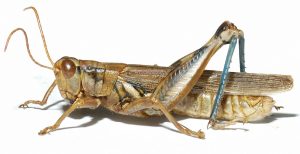
Grasshopper adult
These insects can cause total devastation if an area becomes overrun with an infestation. Grasshoppers are land insects that use their powerful back legs to jump quite high to get away from their predators. In some countries, grasshoppers are seen as part of a nutritious meal, but in most countries they are just seen as a pest because they can have a largely negative effect on crops. Grasshoppers are in their more mobile adult phase in the summer months that are the hottest, and they travel to each area in a swarm. Grasshoppers thrive in dry climates. This sometimes can compound on an existing problem for crops such as extremely dry soil. The invasion of grasshoppers is quite aggressive and rising heat plus lack of rain draws them into crops.
Middle spring is normally when grasshoppers usually begin to hatch. If the weather is especially warm and especially dry, this facilitates an earlier hatching and the nymphs will thrive better. If there is a freeze in the late spring, this will disrupt the cycle and kill the young grasshoppers, and cloudy damp weather will do the same. Summers that are long and hot do provide the best environment for them to thrive, as well as go through an early maturing, and an extended egg-laying period. Summers that are relatively cool slow down the life cycle and shorten the time period for laying eggs. The life cycle for grasshoppers is egg, nymph (young adult), and adult grasshopper. If there is an infestation, it is during the nymph stage that action needs to be taken, that way they do not have the chance to lay eggs as an adult.
Controlling Grasshopper Pest Infestation
Predators to grasshoppers include snakes, toads, cats and skunks. It would be beneficial to keep these animals around if they are already present as long as they are not harming the crops or garden. Birds including mockingbirds, bluebirds, crows, hawks, sparrows, meadowlarks, and brown thrashers are all predators of the grasshopper. Robber flies as well as spiders have been known to consumer grasshoppers, as well as chickens, ducks, and Guinea hens. Field mice and other rodents take a different approach and dig up egg pods as well as feeding on the adults. Praying mantis, as well as fish, consumes grasshoppers. One notable predator of the grasshopper is the blister beetle and ground beetle larvae; both of these bugs are able to consume between 50%-60% of egg pods from grasshoppers.
Other Ways to Control the Population
Some other natural ways to control an infestation are to provide barriers on the crops and plants. There are a few things that may be planted as barrier crops that repel grasshoppers such as cilantro, horehound, calendula peas and sweet clover. Making a natural repellent spray is also an option, a heavy infusion of garlic oil is the best thing to repel them. The spray may be mixed using 3 ounces of minced garlic cloves with 1 ounce mineral oil. This needs to be soaked for 24 hours or longer, then strained. 1 teaspoon of fish emulsion should be mixed with 16 ounces of water, plus 1 tablespoon of castile soap. The fish emulsion should be mixed with the garlic oil in a sealed glass container. This is usable for several months. To use this, mix 2 tablespoons with 1 pint of water and spray where desired or needed.
Nosema locustae may be purchased at a local nursery or on the internet, and is a one celled parasite that kills grasshoppers when they ingest it. Grasshoppers are cannibalistic in nature and eat the dead infected bodies, thus infecting themselves and forcing a chain reaction passed on through generations. A pepper spray made of jalapenos or habaneros with a bit of castile soap may be used to repel adults.
A caffeine spray made of coffee brewed 5-10 times stronger may be used as a spray as well. Although controversial, neem oil is said to disrupt insect growth for grasshoppers in the nymph stage, and grasshoppers that land on plants that have been sprayed with neem oil do not get eaten. When infestations of grasshoppers become out of control, authorities may classify the crops as an Agricultural Disaster. Declaring this as a disaster does bring more attention to the issue, as well as understanding from the residents.

No Comments